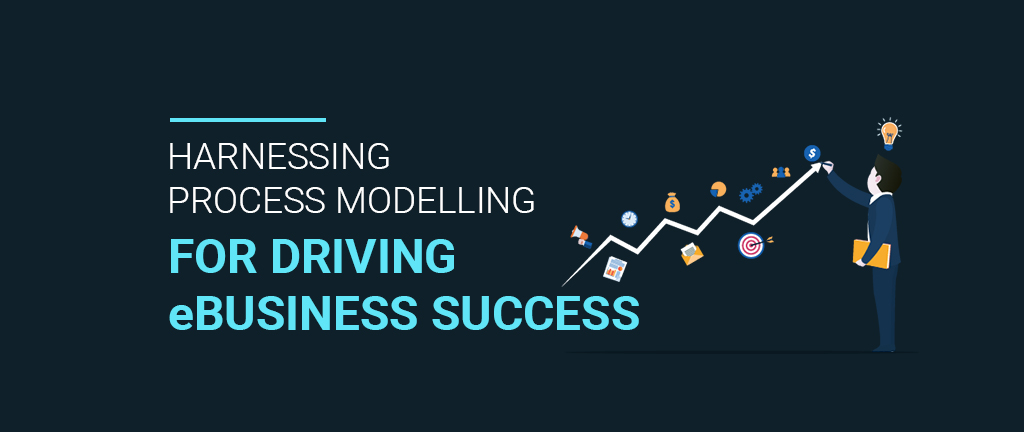The Internet has made an incredible impact on all organisations, creating entirely new challenges on the one hand and, on the other, offering new conveniences. The rise of eBusinesses with the digital boom led to the emergence of many business models but has also necessitated a shift in strategies to gain a competitive edge in the information age.
In the fast-paced and competitive world of eBusiness, finding effective strategies to boost productivity and achieve profitability is paramount. One such strategy that holds immense value is process modelling. By visualising, analysing, and optimising business processes, eBusinesses can unlock a multitude of benefits that directly contribute to their success.
What is Process Modelling?
Process modelling involves graphically representing the processes or actions. Individual steps of the process are drawn out to present an end-to-end overview of the tasks in the processes. A process model allows the visualisation of business processes so organisations can better understand their internal business procedures.
Process modelling lays the foundation of improvement and then automation strategy, as process model allows to identify improvement opportunities by highlighting waste, process bottlenecks and inefficiencies in the current business processes
The Imperative Role of Process Modelling for eBusinesses
In today’s digital age, eBusinesses are thriving with endless opportunities for growth and success. However, operating in the online realm comes with its own set of challenges and complexities. To navigate through this landscape and achieve sustainable success, eBusinesses need a strategic approach that goes beyond traditional business practices. This is where process modelling steps in as a crucial tool for optimising operations, enhancing efficiency, and driving overall success in the eBusiness world
By visualising complex workflows, identifying bottlenecks, and streamlining interactions, eBusinesses can achieve higher levels of productivity, scalability, and adaptability in the ever-evolving digital landscape. Process modelling acts as a guiding framework, enabling eBusinesses to leverage technology, drive innovation, and maintain a competitive edge in the fast-paced online marketplace.
How Process Modelling Helps eBusinesses
We look at key areas where process modelling proves to be a game changer for eBusinesses:
Leveraging Automation: Automation plays a pivotal role in driving eBusiness success. Process modelling helps identify opportunities for automation, enabling organisations to understand high-frequency, highly manual processes with multiple handover points where automation delivers the most advantage.
Driving Consistency and Standardisation: With Process modelling, eBusinesses gain the ability to establish standardised procedures and best practices across their operations. By documenting and visualising processes, organisations can ensure that every employee follows the same guidelines and workflows. This consistency not only improves efficiency but also enhances quality control, reduces errors, and minimises risks. It creates a strong foundation for delivering reliable and consistent digital experiences to customers.
Enhanced agility: Process modelling empowers organisations to quickly adapt to changing market dynamics, customer demands, and technological advancements. By visualising processes, businesses can quickly identify areas for improvement and respond swiftly to stay ahead of the competition.
Improving Customer Experience for Long-Term Success: In the digital landscape, customer experience is a key differentiator. Process modelling enables eBusinesses to map out the customer journey, identifying touchpoints where improvements can be made. Analysing customer interactions allows eBusinesses to personalise their offerings, streamline order fulfilment, and provide exceptional support. This customer-centric approach fosters loyalty and leads to positive word-of-mouth, attracting new customers and driving long-term success.
Enhanced Risk and Compliance Management: Staying ahead of ever-evolving compliance requirements is a necessity for businesses. By documenting business processes, eBusinesses gain a comprehensive understanding of their operations and can identify potential compliance gaps. Complete visibility into processes, including data flow, activities and decision points, ensures process adherence to regulatory frameworks and internal policies.
Collaboration and Communication: Process modelling provides a common language that breaks down departmental silos and facilitates cross-functional collaboration. It enables teams to understand dependencies, handoffs, and roles, improving communication and alignment.
Elevate your eBusiness
Process modelling is not just an option but a necessity for eBusinesses striving for sustainable success in the digital world. One tool that comes with a powerful process modelling module is PRIME BPM. Designed for both business users and process experts, PRIME Modeller makes process mapping accessible for everyone.
From templated tables to drag-and-drop functionalities, PRIME Modeller makes it easy to create consistent and standardised process maps quickly. With the ability to record process attributes, such as Business Rules, KPIs, Text descriptions, Roles, RACI (Responsible, Accountable, Consulted, Informed) matrix, etc., gain complete visibility into your processes and even identify automation opportunities.
Wish to explore PRIME Modeller and other functionalities, including in-built analytics, simulation, and risk and compliance of the PRIME BPM tool at Zero Cost? Get access to a Free License.
